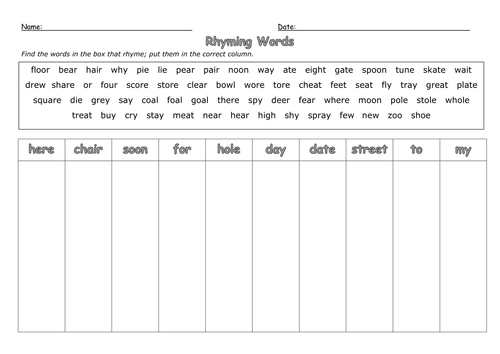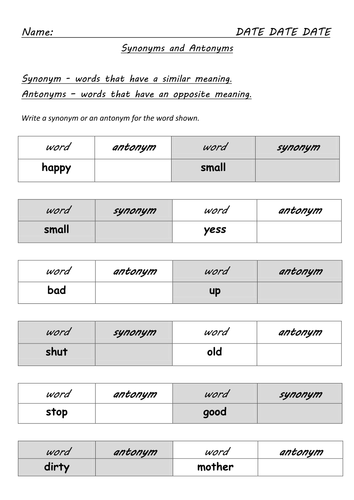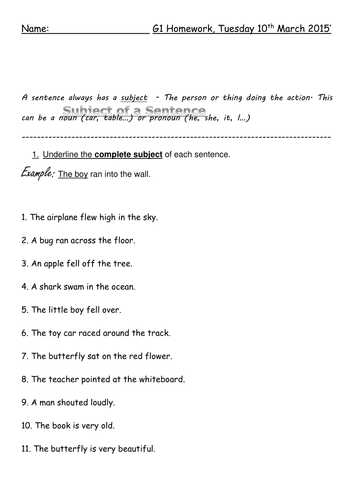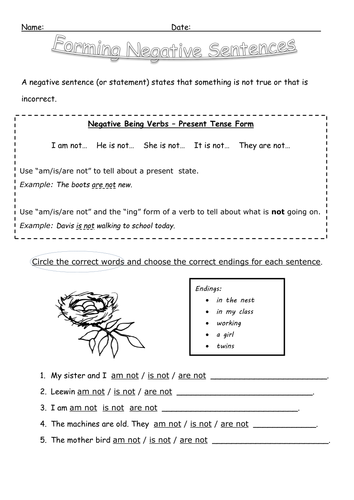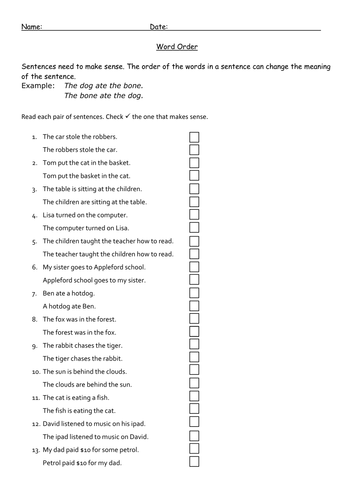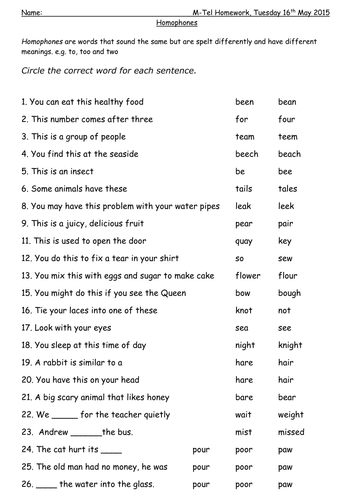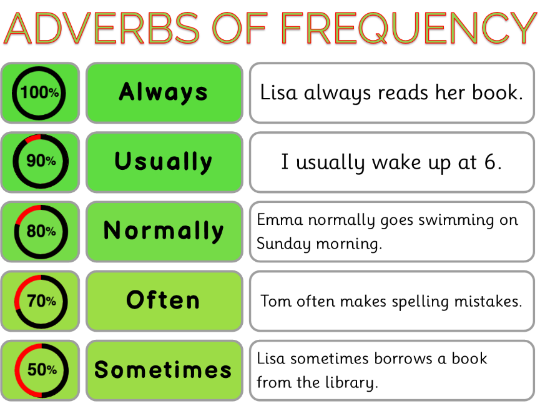401Uploads
1756k+Views
2406k+Downloads
Languages

Rhyming Words Sorting (Tricky Words)
Tricky rhyming words sorting/matching activity.
Includes various different spelling patterns making same vowel sound.

Synonyms and Antonyms Basic
2 basic introductory worksheets for KS1 & ESL student homework.
1: They need to read carefully whether the written answer should be either a synonyms or an antonym.
2: Synonym Sort. with synonyms for good, bad, hot, silent, big, small.
Easy to differentiate - just change the words.

Irregular past Tense Verb Link to Present & Future Tense Verb
On the left simple sentences with irregular past tense verbs.
On the right simple sentences with either present or future tense verb sentences.
Students have to;
1) Link the similar sentences.
2) Underline or highlight the verbs.
25/25 sentences in total. double sided.

Grammar - Subject of Sentence
3 different activities (over 4 pages) to help students identify and think about the subject of a sentence.
1. Underline the complete subject in the sentence.
2. Add an appropriate subject to the sentence.
3. Read the sentence, identify the subject, match to (non-commercial) clip-art.

Negative Sentences Present & Past Tense
A negative sentence (or statement) states that something is not true or incorrect.
Two back:2:back worksheets (4 pages) with a varity of activities used as a homework.
Negative Sentences using 'Being Verbs' present and past form on worksheet_1
Negative Sentences using 'other verbs' present and past form on worksheet_2.
Please rate and review.

Word Order Effecting Meaning
Sentences need to make sense. The order of the words in a sentence can change the meaning of the sentence.
Students read the two sentences and choose the one that makes the most sense.
e.g.
Ben ate a hotdog.
A hotdog ate Ben.
EAL or ESL homework activity.

Homophones Choice
Homophones are words that sound the same but are spelt differently and have different meanings. e.g. to, too and two
Students have to circle the correct word (homophone) for each sentence.
Homework worksheet.
Sale

Food Words Glossary
Food word glossary with 77 carefully selected academic vocabulary words for the IPC unit ‘What’s on the Menu’ (could be used with any food unit of study in any curriculum)
Each word has a definition and a clear picture.
9 A4 pages.
Also included are 54 word wall cards with word and image to use as flashcards or word wall cards.
Both resources designed to support EAL learners grasp essential vocabulary.
Sale

Simple and Compound Sentences
Simple and Compound Sentences Task Cards
This engaging set of task cards helps students differentiate between simple, compound, and incomplete sentences. Designed for Year 3 learners, including EAL students, the cards feature clear vocabulary and illustrations to support understanding and maintain interest. Examples of “not a sentence” are included to reinforce key grammar concepts like capital letters, punctuation, subjects, and verbs.
Perfect for classroom practice, this resource includes two recording sheets: one for tasks 1-20 and another for 21-40, making it ideal for extending learning or for fast finishers. Students simply read each numbered card and record their answer (A, B, or C) on the corresponding sheet.
This set is an excellent tool for promoting grammar awareness and sentence classification skills in young learners.
Sale

Grimm's Fable Reading Comprehension
Differentiated reading comprehension for the humorous fable “The Mouse, The Bird and The Sausage” by the Brothers Grimm. A boastful bird convinces his friends to switch household roles. The dissatisfied mouse, bird, and sausage then fail comically in their unfamiliar duties, leading to their disastrous demise. This fable warns readers against upending a functional system due to the dangers of pride and envy.
Suitable for Key Stage 3 and 4 readers.
Includes 4 versions of question sheets:
➊ A 19 question classic comprehension sheet with literal and factual questions about the story.
➋ A 12 question sheet with higher level comprehension questions.
➌ A 21 True or False question sheet.
➍ A 35 question SAT-style multiple choice sheet with questions on facts, main ideas, details, sequencing, inferences, vocabulary, true/false, cause and effect, and author’s purpose.
All question sheets come with corresponding answer sheets.
Sale

Lion and Mouse Fable
Differentiated reading comprehension fable retellings of Aesop’s ‘The Lion and the Mouse’
These differentiated retellings of Aesop’s “The Lion and the Mouse” offers three levels of complexity (higher, middle, and lower), students of all abilities can engage with the text and develop their skills. The higher level includes more advanced vocabulary and ten in-depth comprehension questions, while the middle level offers simpler synonyms and nine questions. The lower level is the easiest to read, with a shorter text and seven questions. All levels come with a handy answer key.
Sale

Adverbs of Frequency Mats Worksheets
Adverbs of frequency word mats and adverb of frequency worksheets.
Also adverb of frequency poster.
Sale

o_e split digraph
o_e split digraph
o_e split digraph worksheets (30 words, 30 clip-art, words on separate page)
o_e split digraph flashcards (2 version with 40 words and illustrations)
o_e split matching game (40 words, match word to image memory game)
Sale

Bremen Town Musicians Reading
Reading Comprehension for the Brothers Grimm’s “The Bremen Town Musicians”
In this classic folk tale, an aging donkey meets up with a worn-out hunting dog, an old cat, and an elderly rooster, all of whom have faced hardship with their masters. Seeking a fresh start, the loyal friends embark on a journey together to Bremen to begin new lives as musicians. After spending the night in a forest along the way, the determined animals follow a light to a cottage inhabited by robbers. By making loud noises together, the clever companions are able to work as a team to scare off the outlaws. In the end, the four newfound friends contentedly take over the abandoned house, seeming to have found their happy new home together.
This reading comprehension resource includes:
➼ A reading passage written at an approximate 8-11 year old reading level
➼ A 27-question SAT-style multiple choice quiz
➼ A 15-question comprehension worksheet with factual, sequencing, vocabulary, main idea, and theme questions, plus a ‘write a summary’ prompt
With answer sheets
Sale

The Golden Goose Reading Comprehension
Reading comprehension for the traditional tale** ‘The Golden Goose’ by the Brothers Grimm.**
In this classic story of kindness rewarded, a generous but mistreated younger brother named Simpleton shares his meager pancake with a magical dwarf and is rewarded with a golden goose and the hand of the princess. With the help of the grateful dwarf, Simpleton overcomes the unreasonable demands of a biased king and eventually inherits the kingdom. This entertaining traditional tale retelling imparts a moral lesson about how generosity and perseverance can be rewarded.
Download includes:
➊ Double-sided eading passage (a faithful retelling of the Grimms version) written at an approximate year 3 or 4 level for readers aged 7-9 years old.
➋ A 31 question multi-choice SAT Style comprehension sheet, including a mix of factual, main idea, detail, sequencing, inference, vocabulary, true or false, cause and effect, and authors purpose questions.
➌ A classic, write the answers on the line, 21 reading comprehension question worksheet.
➍ True or False? Activity with 32 statements.
Answer sheets for all versions.
*Not to be confused with the Aesop fable “The Goose Who Laid the Golden Eggs”, which is also available from my shop / via this link *
https://www.tes.com/teaching-resource/resource-12868064
Sale

Simile Flashcards: Quiz-Quiz-Trade Activity
Get Moving with Similes: Active Learning Cards
Enliven your English lessons with this dynamic set of simile cards, perfect for active learning and speaking activities. This comprehensive resource uses the Quiz-Trade approach to develop pupils’ understanding and creative use of figurative language through movement and peer interaction.
Contents:
Set 1: Illustrated Simile Cards (70 double-sided cards)
Front: Vibrant illustrated similes
Reverse: Concise explanations detailing both the literal meanings and, for similes with dual meanings, the idiomatic interpretations.
Set 2: Creative Writing Simile Prompts (70 single-sided cards)
Illustrated prompts (such as “as strong as…,” “as boring as…,” “as fun as…”)
Designed for independent simile creation
Supports creative thinking and literacy development
Ideal For:
Key Stage 2 and 3 English
Literacy intervention groups
EAL pupils
Whole-class active learning
Creative writing warm-ups
This hands-on resource transforms simile learning into an active, engaging experience as pupils move about the classroom, exchanging cards and crafting their own similes. The two-tiered approach supports differentiated learning - starting with complete similes before progressing to independent creation - perfect for meeting National Curriculum requirements while keeping pupils active and engaged as they develop from understanding existing similes to confidently creating their own descriptive comparisons.
For additional simile practice, check out my Simile Matching Cards resource
Sale

Simile Matching Activity Vocab Cards
Simile Matching Cards: Enliven Your English Lessons!
Are your pupils as puzzled as a hedgehog in a balloon factory when it comes to similes? Illuminate their understanding like a lighthouse on a foggy night with my engaging “Simile Matching Cards” resource!
What’s Included:
66 illustrated similes
6 A4 pages, each with 11 similes
Two common simile structures:
“As [something] as a”
“Like a”
Visually Appealing:
Each sentence card features key words illustrated in an engineered text style, making them stand out like a toucan in a penguin colony! This unique design helps emerging readers and EAL learners grasp concepts as easily as a duck takes to water.
Perfect for:
Key Stage 2 English
Early Key Stage 3 English (Year 7)
Supporting EAL learners
Literacy intervention groups
Benefits:
Develops creative writing skills
Enhances vocabulary and reading comprehension
Supports visual learners and kinesthetic learning styles
Makes learning as enjoyable as a day at the seaside!
Don’t let similes puzzle your pupils like a jigsaw with missing pieces. With these Simile Matching Cards, they’ll be as comfortable with figurative language as a bird in flight.
Check out my Similes Quiz-Quiz-Trade Fun Flashcards
Sale

Billy Goats Gruff Reading Worksheets
Differentiated reading comprehension worksheets for The Billy Goats Gruff, suitable for readers ages 6-11.
This pack includes:
3 leveled reading passages:
Lower-level text simplified for beginning readers (approx. year 2)
Mid-level text a wider range of words (approx. upper year 2/year 3)
Original text published in 1859 for more advanced readers (approx. year 4-5)
16 differentiated activity sheets to check comprehension at each level:
Higher-level (original text) includes:
- 12 question classic comprehension worksheet
- 32 question true/false worksheet
- 29 question SAT-style multiple choice worksheet
- 2 crossword versions using vocabulary found in the text
Mid-level includes:
- 16 question classic comprehension worksheet
- A matching 16 question worksheet with multiple choice answer options
- 36 question multiple choice worksheet
- Sequencing/cloze (missing word) story summary worksheet
- 2 crossword versions
Lower-level includes:
- 9 question classic comprehension worksheet
- 13 question classic comprehension worksheet
- A matching 13 question worksheet with multiple choice answer options
- 36 question yes/no worksheet
- Crossword
Answer sheets are provided for all levels of worksheets.
Sale

Puss in Boots Reading Comprehension
12 versions of differentiated reading comprehension for the classic fairy tale ‘Puss in Boots’, suitable for readers aged 6 to 12 years.
The higher-level text uses more complex vocabulary, includes more details, and employs additional literary devices. It has a larger word count and is 2 A4 pages in length. Three versions of comprehension questions come with this level text:
➊ A classic worksheet with 16 questions (wherein students write answers on lines below the questions)
➋ A multiple-choice SAT style version with 26 mixed-level questions, each with 3 answer choices
➌ A multiple-choice vocabulary version with 14 vocabulary questions, each with 3 answer choices
The middle-level text has a slightly smaller word count and simpler vocabulary. It spans 2 A4 pages in length and is accompanied by four sets of comprehension questions:
➍ A classic 16 question worksheet
➎ A classic 8 question worksheet
➏ A multiple-choice SAT style version with 28 mixed-level questions, each with 3 answer choices
➐ A multiple-choice SAT style version with 27 mixed-level questions, each with 4 answer choices
The lower-level text has been simplified and shortened for easier reading, using decodable words whenever possible, while keeping the key details, main plot points, and essence intact. It spans 2 A4 pages in length and includes six sets of questions:
➑ A classic worksheet with 15 questions
➒ A classic worksheet with 7 very easy questions
➓ A multiple-choice style version with 7 very easy to read-questions and 3 answer choices
⓫ A multiple-choice Key Stage 2 SAT style version with 15 mixed-level questions and 3 answer choices
⓬ A multiple-choice Key Stage 2 SAT style version with 27 mixed-level questions and 4 answer choices
Answer sheets are provided for all levels of worksheets.

